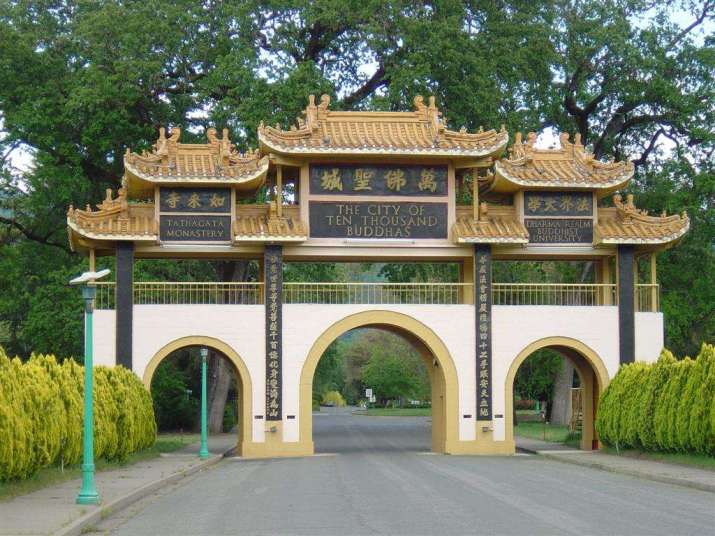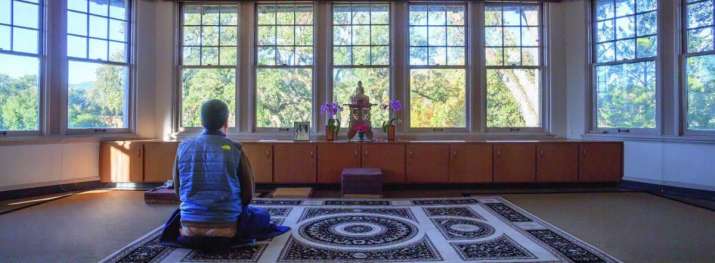FEATURES|THEMES|Philosophy and Buddhist Studies
Entering the Dharma Realm
 Entrance to the City of Ten Thousand Buddhas. From wikipedia.org
Entrance to the City of Ten Thousand Buddhas. From wikipedia.orgAt the end of a long, narrow road through the rural agricultural town of Ukiah in Northern California is an immense arched gate in distinctive Chinese architectural style. The roof is clad with tiles of Taiwanese clay, adorned with dozens of mythic animals that serve as spiritual guardians. A prominent banner announces the entrance to the City of Ten Thousand Buddhas (CTTB) in both English and Chinese. The gate is an unexpected sight in this small town on the edge of wine country. Clearly, it marks a departure from “conventional” American culture and an entry into an entirely different realm. The City of Ten Thousand Buddhas, established between 1974 and 1976, is one of the oldest and largest Buddhist communities in the Western Hemisphere.
On the left side of the gate, a sign features the title of Tathagata Monastery, one of the first Chan monasteries in the US, home to more than 100 monks and nuns. To the right, another sign announces Dharma Realm Buddhist University (DRBU), a liberal arts institute emphasizing higher education in the classics of Buddhist literature. Hundreds of monastics, volunteers, faculty, staff, and students share dozens of buildings and thousands of rooms on the 480-acre campus where they study, meditate, live, work, and play together.
The majority of people passing through the gate are disciples of Venerable Master Hsuan Hua (1918–95), founder of the CTTB. Hundreds of retreatants and pilgrims visit from around the world to celebrate important Buddhist holidays, such as the birthday of Guanyin’s and Shakyamuni Buddha’s parinirvana. Many stay for days to attend recitation sessions or to participate in a Chan meditation retreat, silently sharing meals with monks and nuns and practicing ceremonies and meditations in the city’s main Buddha Hall.
 Dharma Realm Buddhist University meditation room. From drbu.edu
Dharma Realm Buddhist University meditation room. From drbu.eduHowever, the City of Ten Thousand Buddhas is not simply a destination for Buddhist pilgrims and disciples. Alongside the monastic community is a trio of schools: a primary school for young children, a high school—separated into boys’ and girls’ divisions—as well as the accredited university. While the students of these schools are eager to learn the principles and applications of Buddhist texts, many are not religious Buddhists. Their dedication is to learning rather than religious devotion. Dharma Realm Buddhist University was established alongside Tathagata Monastery as part of Venerable Hua’s mission to help bring the Buddhadharma to the Western world. While Buddhist ceremonies and meditation practices are essential to spiritual cultivation, so too is education and the development of critical thinking and textual interpretation skills. To ensure that the Buddhist traditions will be preserved and transmitted effectively, the university was established to provide thorough education in the classical texts and languages that have preserved the Buddhadharma for more than 2,500 years.
Dharma Realm Buddhist University is unique among higher education institutions in the Western world. As an accredited liberal arts university offering bachelor’s and master’s degree programs, the curriculum is not overtly religious. DRBU does not offer divinity training or seek to recruit devotees for the monastery. Nonetheless, the educational emphasis is on the transformative power of Buddhist ideas and practices. The deeper meanings of the classical texts are revealed through contemplative exercises. Each semester, one week of classes is suspended and the entire university participates in a group meditation or recitation retreat, where the students are encouraged to develop the stillness and patience to allow deeper inner insight to emerge. Rather than being trained in a prescribed set of facts, students develop tools for inquiry that stimulate their latent capacity for understanding. Classical texts have a lot to say about the techniques and strategies for exploring one’s mind and role in the natural world, and DRBU’s educational model puts students face to face with their own process of personal revelation and self-development.
Students read the classical texts—not only Buddhist sutras but also Chinese, Indian, and Western classics—and are encouraged to develop original thinking and new interpretations of traditional ideas. The emphasis focuses on revealing wisdom, developing virtue, and uncovering innate humanity. DRBU professor Doug Powers often tells students that the goal of a Buddhist liberal arts education isn’t to propagate Buddhism but to return people to their own humanity. Classical texts are studied not only for their historical or cultural significance, but also for how they impact learners in the present day, and thus their implications for modern society. In the words of DRBU admissions counselor Ken Cannata, “We don’t teach students what to think, we teach them how to think.”
In an educational marketplace increasingly oriented toward training business and technical skills, DRBU pioneers a renaissance of liberal arts influenced by Buddhist values such as ethics, virtue, sensitivity, and mindfulness. Classes are conducted entirely in a discussion-based seminar format, requiring students to fully engage with the texts, their teachers, and fellow students. The inherently multicultural nature of the City of Ten Thousand Buddhas—consisting of monastics and lay people from a diversity of cultures—catalyzes deeper listening and a reflective approach to problem-solving.
The Dharma Realm, then, is not a mythical Pure Land, but becomes the potential for the higher aims of humanity to influence and inspire a new generation of leadership. The university represents the ideal of 21st century global pluralism; ancient ways of thinking and being from across traditions and cultures intermingle in an environment that fosters introspection and personal growth. Buddhist traditions spanning generations emerge in a contemporary setting of critical thinking. The values of traditional, pre-industrial cultures are interpreted in a modern context in which innovative thinkers are contemplating solutions to 21st century problems.
Related features from Buddhistdoor Global
Toward a Multi-faith Vision of University Chaplaincy in America: An Interview with Reverend Greg McGonigle
Pilgrimage
The Development of Chinese Buddhism in the US: Interview with Venerable Chaofan
Prof. Ven. Dhammajoti on Studying Original Texts and Languages and Approaching Buddhism with Integrity and Rigor
Developing Consideration of Others
Related news from Buddhistdoor Global
Dharma Realm Buddhist University Announces Scholarship Program for Students Affected by Disaster
Dharma Realm Buddhist University Exhibits Ceramic Reliefs Portraying the Life of the Buddha
Dharma Realm Buddhist University in Northern California Gains Academic Accreditation
California Wildfire Update: Abhiyagiri Monastics Return Home After Sheltering at the City of Ten Thousand Buddhas














